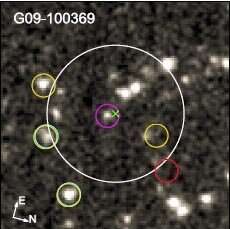Ultrared, dusty star-forming galaxies in the early universe

Star formation takes place within natal clouds of dust and gas that absorb much of the emitted ultraviolet and optical radiation but which also block these regions from optical view. In recent decades, however, infrared space-based observatories like Herschel and Spitzer have revolutionized our understanding of obscured star formation in dusty galaxies because infrared light can penetrate the dust clouds to reveal the stars being formed. Herschel and Spitzer have discovered large numbers of very dusty, very red star-forming galaxies that are immensely luminous in the infrared (exceeding one trillion solar-luminosities) yet are not seen at shorter wavelengths. In fact, these dusty galaxies are responsible for most of the infrared background light in the cosmos. Some of these objects display the most extreme kinds of starbursts known, with star formation rates exceeding a thousand per year, but which are also exceedingly rare with on average only one of them in a volume of a few hundred thousand million cubic light-years.
The Herschel mission, exploring the sky in far-infrared wavelength bands where the dust emission peaks, discovered thousands of candidate dusty galaxies. CfA astronomer Matt Ashby was a member of a large team of astronomers who helped to characterize these galaxies more fully. The team identified a set of three hundred "ultrared" galaxies (that is, brightest at the longest infrared wavelengths) and that had also been observed at shorter infrared wavelengths by the IRAC camera on Spitzer. The team gathered additional submillimeter and millimeter data to fully assess these galaxies' output, and spectra to determine their distances and luminosities. The most distant galaxy they found is from the epoch about one billion years after the big bang (a redshift of 6.02); it is one of twenty-three sources in the study that are confirmed to be gravitationally lensed.
The astronomers conclude that these ultrared galaxies, although they include some of the most luminous and massive galaxies known, are too rare to represent the star-forming progenitors of local, quiescent galaxies; other kinds of galaxies will have to fill that role. But the new study has identified the most extreme cases, and further investigations of these monsters will help determine how extreme star formation in the universe operates.
More information: Jingzhe Ma et al. Spitzer Catalog of Herschel-selected Ultrared Dusty Star-forming Galaxies, The Astrophysical Journal Supplement Series (2019).
Provided by Harvard-Smithsonian Center for Astrophysics




















